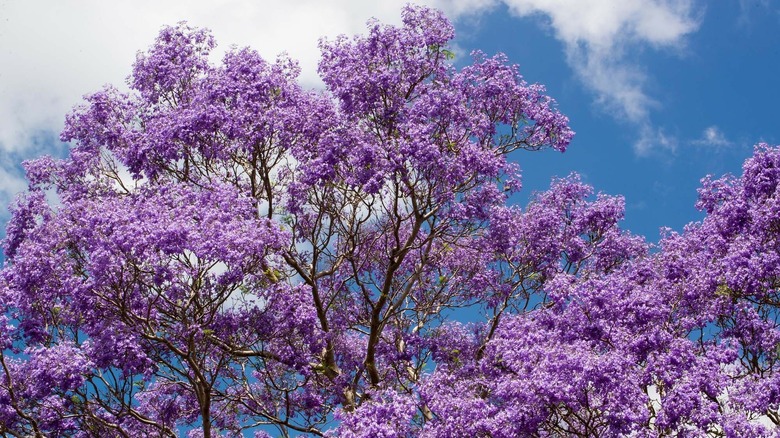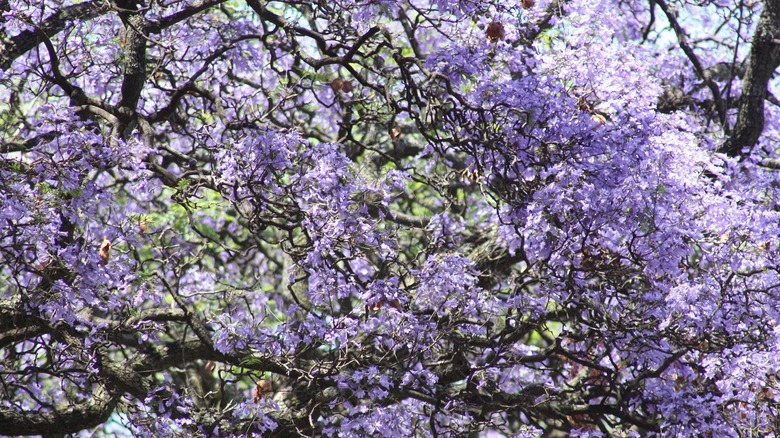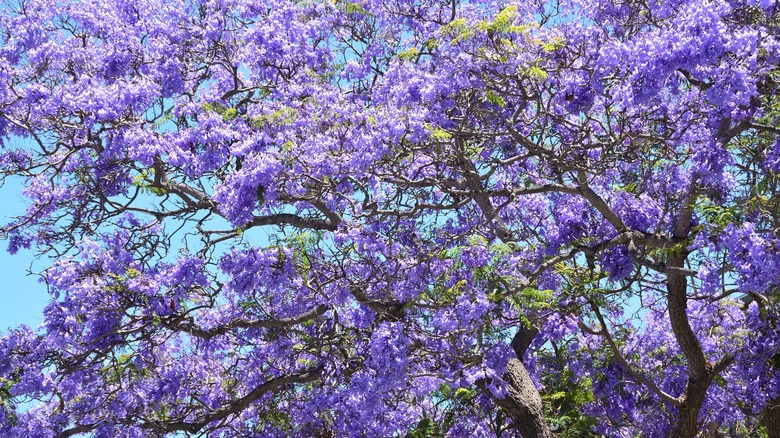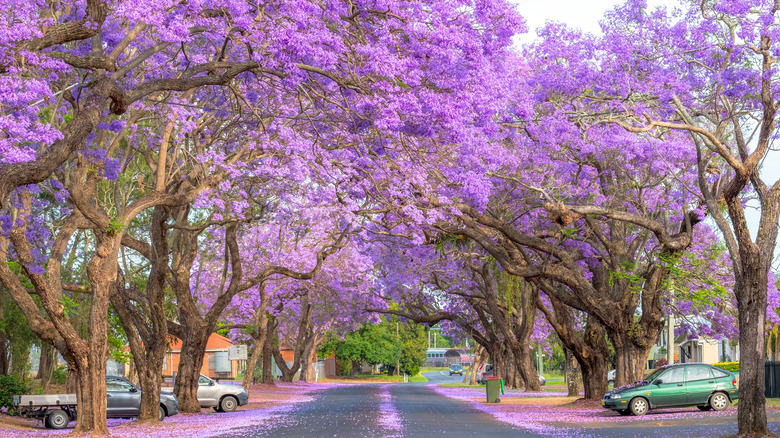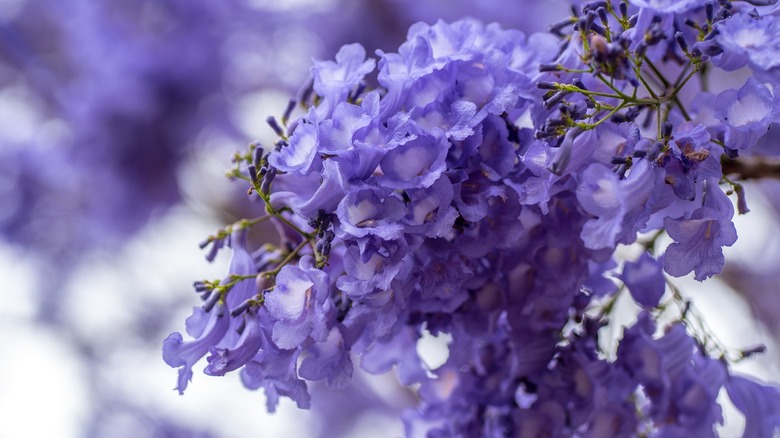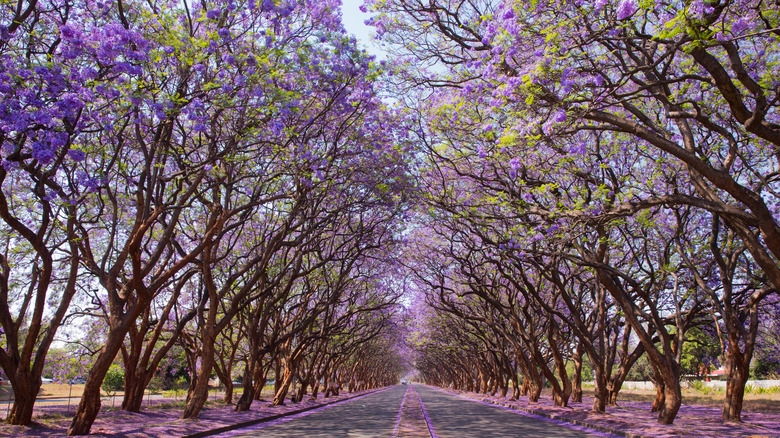How To Grow And Care For Jacaranda Trees
Jacaranda trees, or jacaranda mimosifolia, are stunning trees popular in southern regions of the United States, native to South America. They are unmissable when in bloom, with large, vibrant lavender or blue blossoms creating stunning visual interest. In appropriate climates, jacaranda trees are usually seen lining streets, which creates a fantasy-esque whirlwind of purple flowers during blooming seasons. They are also non-toxic to humans and animals, belonging to a family of plants called bignoniaceae, per the ASPCA.
Jacaranda trees represent good luck, rebirth, wealth, and wisdom, according to The Tribute. They are also associated with the Amazonian moon goddess who came from the tree to educate people. According to the legend, when she returned to the tree, it sprouted its famous purple-blue flowers (via Classroom). In the U.S., it is considered good luck when a jacaranda flower falls on your head. These mystical purple and blue trees are relatively easy to care for, given the proper climate and care. Read on to learn how to grow and care for jacaranda trees.
How to use jacaranda trees in garden
Jacaranda trees are popular trees in warmer climates, growing best in USDA hardiness zones 9b through 11, such as in parts of Florida, Texas, and California, per Gardening Know How — check to ensure the plant will survive in your hardiness zone. They are also considered invasive in some areas, such as Queensland, Australia (via The Green Pinky).
Jacaranda trees also grow to enormous sizes. They can be as tall and wide as 60 feet, and prefer full sun for optimal blooming. If you're planning on planting a jacaranda tree in your yard, make sure you are planting it far enough away from your house so it doesn't block out any natural sun coming in. On the flip side, if you would like to shade your house from direct sun, consider planting a jacaranda tree. They are commonly used to line streets and create shade.
Also be aware that jacaranda blooms will fall regularly during blooming season. While this can create a beautiful scene, the leaves will quickly decompose and get slimy, so either plant it somewhere that you will regularly clean up the fallen leaves, or where decomposing leaves won't cause a safety hazard (such as lining a street). Love to Know recommends planting jacaranda trees away from pools and other water structures.
How to grow jacaranda trees
Growing a jacaranda tree can be done in a variety of ways, such as grafting, softwood cutting, from seed, and propagation. While every way will produce a healthy tree, the easiest way for the average gardener is via propagating a stem cutting. To obtain a cutting, look for a branch on an existing jacaranda tree that is at least 1/2 of an inch wide in diameter, per The Spruce. Using clean gardening shears, cut off 3 to 4 inches of the branch. Ideally, you should cut a branch with nodes, but it's not necessary.
From there, you will need to decide how you'd like to develop a root system — in water or in dirt. If you want to begin propagation via water, begin by filling a large, clear glass or jar with distilled water. Add the cutting, and expect root growth within a few weeks. Let the roots grow at least 1 inch long before repotting. Add more water once a week as it evaporates.
To grow the cutting in a pot, or transplant the water grown roots to a pot, fill a starter pot with a soilless, perlite-based mix, or a sandy mix. Dust the cutting with rooting hormone, and add to the pot. Keep watered and in bright, indirect sun. Let the root system develop for at least eight months, and then transplant into a 5 gallon pot, or in the ground.
How to care for jacaranda trees
Caring for jacaranda trees is relatively easy if they are being grown in the proper zone and climate. They should not be exposed to temperatures colder than 15 degrees, per Gardening Know How, though that's their extreme. Jacaranda trees like being planted in well draining, sandy soil, according to SFGate, and dislike being left in watery, moist conditions. While jacaranda trees are drought tolerant, they shouldn't be neglected. Check the soil regularly, and water when the top 3 to 4 inches are dry. This is likely to happen when there is no rainfall, or in temperatures above 95 degrees. They prefer being in full sun conditions, but they can tolerate partial shade.
Fertilize at the beginning of the spring with a 10-10-10 fertilizer. Opt for a granule-based, slow release fertilizer for the most long term benefit. Jacaranda trees should also be pruned once a year, preferably in the late winter while they're still dormant. Using clean pruning shears, prune stray, awkward, or sick branches, but do not remove more than 1/4 of the tree's branches.
Varieties of jacaranda trees
According to LAist, there are 49 varieties of jacaranda trees. While jacaranda trees are most loved for their purple-blue flowers and breathtaking size, their varieties have varying colors and smaller sizes. Some of them can provide the allure of a jacaranda in a more compact area, or without the purple overwhelming your yard. Here are just a few varieties from The Spruce:
- Jacaranda Jasminoides: This compact variety only grows anywhere from 10 to 25 feet tall, and is identifiable by its dark purple flowers.
-
Jacaranda Jasminoides 'Maroon': A hybrid of Jacaranda Jasminoides, this dwarf variety also only grows up to 25 feet, and is identifiable by its maroon flowers, as the name suggests.
-
Jacaranda Mimosifolia 'Alba': Also called 'White Christmas,' this full sized variety produces white flowers, almost akin to parchment paper.
-
Jacaranda Mimosifolia 'Bonsai Blue': This dwarf jacaranda variety only grows up to 12 feet tall, and produces purple, if not periwinkle, colored flowers.
How to repot jacaranda trees
If you live somewhere too cold to sustain a jacaranda tree year round, or they are considered invasive where you live, or you want just a more compact, non permanent jacaranda, you can choose to grow them in large pots. According to Gardening Know How, potted jacarandas will only grow 8 to 10 feet tall, and can be brought inside during the winter.
When repotting a jacaranda, either from a propagation or repotting a previously grown plant, make sure the pot is at least 5 gallons. Fill with sandy or loam-based soil, and ensure it is a high quality, well-draining mix. Remove the jacaranda from its current pot, or from its starter propagation pot, and add it to the new container. Ensure the roots are properly buried, and fill with more soil. Water thoroughly and let drain completely. Since they are not receiving in-ground nutrients, fertilize three times a year — early spring, summer, and early fall.
